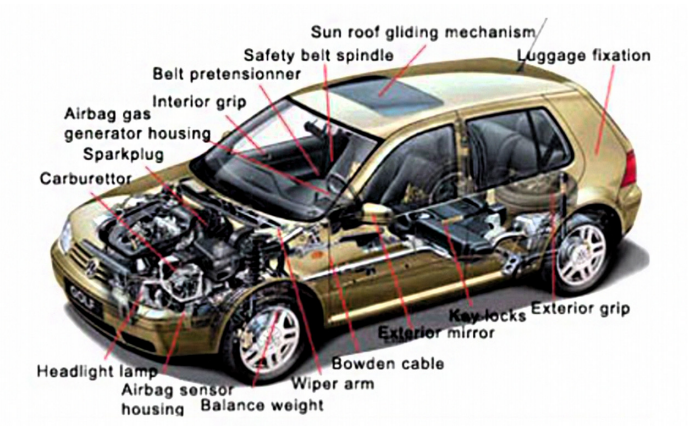1. 概要:
- タイトル: Automobile Parts Casting-Methods and Materials Used: A Review
- 著者: Madhav Goenka, Chico Nihal, Rahul Ramanathan, Pratyaksh Gupta, Aman Parashara, Joel Jb
- 発行年: 2020年
- 発行学術誌/学会: Materials Today: Proceedings 22 (2020) 2525-2531
- キーワード: Centrifugal Casting; Die Casting; Engine Block; Piston; Al-Si Alloys; CGI
2. 研究背景:
- 研究テーマの社会的/学術的背景: 自動車は年々洗練されており、製造業者は強度対重量比の高い様々な材料を使用して自動車の車両重量を削減しようと努めています。 NCAP によって設定された高い基準に準拠するために、自動車の様々な部品は以前よりもはるかに強力に製造されています。 これは、自動車メーカーが自動車部品を製造するための新しい革新的な方法を考案することを促しています。
- 既存研究の限界点: 論文はレビュー論文であり、既存研究の限界点を明確に言及していませんが、軽量化および高強度自動車に対する継続的な要求が鋳造分野の研究の必要性を強調しています。
- 研究の必要性: 自動車部品の製造に使用される様々な鋳造プロセスと部品の製造に使用される材料を取り上げ、各プロセスに最適な材料と各プロセスの長所と短所を簡潔に議論する必要性が提起されています。
3. 研究目的及び研究質問:
- 研究目的: 本論文は、自動車部品の製造に使用される様々な鋳造プロセスと自動車部品の製造に使用される材料を取り上げることを目的としています。 また、各部品に最適な材料を議論し、各プロセスの長所と短所を簡潔に議論することを目標としています。
- 核心研究質問: 自動車部品に使用される様々な鋳造プロセスは何ですか? これらの部品に使用される材料は何ですか? 各鋳造プロセスおよび材料の組み合わせの長所と短所は何ですか?
- 研究仮説: レビュー論文であるため、研究仮説は明示されていません。
4. 研究方法論
- 研究設計: レビュー論文
- データ収集方法: 自動車部品鋳造分野の既存研究および産業事例に関する文献レビュー
- 分析方法: 様々な鋳造方法および材料に関する記述的レビューおよび比較分析
- 研究対象及び範囲: 自動車部品に使用される鋳造方法 (Green sand casting, Centrifugal casting, Lost- foam casting, Die casting, Squeeze casting) および材料 (Grey cast iron, CGI, Al-Si alloys, Magnesium alloy, Titanium casts, MMCs)
5. 主要研究結果:
- 核心発見事項: 自動車部品に使用される5つの鋳造方法と材料の概要を提供し、各方法の利点、欠点、および適切な応用分野を強調しています。 Die casting は高コストにもかかわらず広く使用されており、green sand casting は安価な代替案、centrifugal casting は円筒形部品に最適、lost foam は複雑な形状に最適、squeeze casting は高強度部品に最適です。
- 統計的/定性的分析結果:
- 表 1 は、CGI と Grey cast iron の機械的特性の違いを示しています。 Compacted Graphite Cast Iron は Grey Cast Iron よりも弾性率 (Modulus of Elasticity; GPa) が "170-190" GPa で "98-110" GPa より高く、引張強度 (Tensile Strength; Mpa) が "300-600" Mpa で "160-320" Mpa より高いです。
- 表 2 は、Al および Mg の一般的なダイ温度と寿命を示しています。 Al ダイカストの最大ダイ寿命 (Max die life (number of cycles)) は "10,00,000"、ダイ温度 (Die temperature (°C)) は "288°C"、鋳造温度 (Casting temperature (°C)) は "660°C" です。 Mg ダイカストの最大ダイ寿命は "1,00,000"、ダイ温度は "260°C"、鋳造温度は "760°C" です。
- Centrifugal casting で製造されたピストンの硬度は、ピストンスカートからピストンヘッドまで "23.7HRB" 増加しました。
- Centrifugal casting で作ったピストンの線膨張係数は "15.3*10-6 K-1" で gravity permanent mould casting で作ったピストンより約 "23%" 低いです。
- Centrifugal casting で作ったピストンの耐摩耗性改善率は gravity permanent mould casting で作ったピストンより "70.4%" 高いです。
- AlSi6Cu2Mg 合金に Sb, Sr, Sb を添加すると、合金の流動性がそれぞれ "25%" および "15%" 減少します。
- Squeeze casting 部品は die casting よりも機械的特性が "20-30%" 優れています。
- データ解釈: 各鋳造方法と材料は特定の長所と短所を持っており、コスト、強度、形状の複雑さ、および表面仕上げなどの要求事項に応じて様々な自動車部品に適しています。
- Figure Name List:
- Fig. 1. Aluminium Die Cast Parts.
- Fig. 2. Flow chart of manufacturing of MMC pistons using squeeze casting.
- Fig. 3. The process of squeeze casting.



6. 結論及び考察:
- 主要結果要約: Die casting は高コストにもかかわらず自動車部品鋳造に広く使用されています。 Green sand casting は安価な代替案として使用できます。 部品要求事項に応じて特殊なプロセスを使用できます。
- 研究の学術的意義: 自動車部品用鋳造方法および材料に関する包括的なレビューを提供し、当該分野の研究者およびエンジニアに有益です。
- 実務的示唆点: コスト、性能、および製造要求事項を考慮して、自動車部品の特定の要求事項に応じて適切な鋳造方法および材料を選択するのに役立ちます。
- 研究の限界点: レビュー論文として、新しい実験データまたは詳細な分析を提示するのではなく、既存の知識を要約します。 広範な概要であり、各鋳造方法の特定の側面を深く掘り下げていない可能性があります。
7. 今後の後続研究:
- 後続研究方向: 論文は今後の研究方向を明確に提示していませんが、内容に基づいて今後の研究は、特定の材料および自動車部品に対する鋳造プロセスの最適化、新しい鋳造技術の開発、またはより優れた性能と軽量化のための材料特性の改善に焦点を当てることができます。
- 追加探求が必要な領域: 今後の研究では、自動車部品製造の効率性と性能向上に向けて、高度な鋳造技術、材料革新、およびプロセス最適化を探求することができます。
8. 参考文献:
- [1] H. Nguyen, "Manufacturing Processes and Engineering Materials Used in Automotive Engine Block," Mater. Sci. Eng. Sect. B, EGR250, pp. 11-23, 2005.
- [2] A. V. Adedayo, "Effects of addition of iron (Fe) filings to green moulding sand on the microstructure of grey cast iron," J. Brazilian Soc. Mech. Sci. Eng., vol. 32, no. 2, pp. 171-175, 2010.
- [3] D. Anantha Padmanaban and G. Kurien, "Silumins: The automotive alloys," Adv. Mater. Process., vol. 170, no. 3, pp. 28–30, 2012.
- [4] G. Chirita, D. Soares, and F. S. Silva, "Advantages of the centrifugal casting technique for the production of structural components with Al-Si alloys," Mater. Des., vol. 29, no. 1, pp. 20–27, 2008.
- [5] N. Periyasamy, "Thermal Analysys and Material Optimization of Piston in IC Engine," no. 3, pp. 1132-1144, 2018.
- [6] Q. Bakhsh, D. Ali, A. Ahmed, M. S. Wahab, K. Kamarudin, and A. A. Raus, "Mechanical Properties, Material and Design of the Automobile Piston: An Ample Review," Indian J. Sci. Technol., vol. 9, no. 36, pp. 5-11, 2016.
- [7] P. Scarber, H. Littleton, and A. Druschitz, "Preliminary Study of Compacted Graphite Iron Engine Blocks Produced by the Lost Foam Casting Process," AFS Trans, pp. 881-890, 2009.
- [8] R. Colás, J. Talamantes-Silva, S. Valtierra, F. Morales, and A. J. Pérez-Unzueta, "Cast-In Hypereutectic Aluminum Liners for Engine-Blocks," J. Manuf. Sci. Eng., vol. 131, no. 1, p. 014502, 2009.
- [9] M. Javidani and D. Larouche, "Application of cast Al-Si alloys in internal combustion engine components," Int. Mater. Rev., vol. 59, no. 3, pp. 132-158, 2014.
- [10] E. Aguirre-De La Torre, U. Afeltra, C. D. Gómez-Esparza, J. Camarillo-Cisneros, R. Pérez-Bustamante, and R. Martínez-Sánchez, "Grain refiner effect on the microstructure and mechanical properties of the A356 automotive wheels," J. Mater. Eng. Perform., vol. 23, no. 2, pp. 581-587, 2014.
- [11] B. Zhang, S. L. Cockcroft, D. M. Maijer, J. D. Zhu, and A. B. Phillion, "Casting defects in low-pressure die-cast aluminum alloy wheels," Jom, vol. 57, no. 11, pp. 36-43, 2005.
- [12] M. V. Kevorkijan, "MMCs for automotive applications," Am. Ceram. Soc. Bull., vol. 77, no. 12, pp. 53-59, 1998.
- [13] S. W. Youn, C. G. Kang, and P. K. Seo, "Thermal fluid/solidification analysis of automobile part by horizontal squeeze casting process and experimental evaluation," J. Mater. Process. Technol., vol. 146, no. 3, pp. 294-302, 2004.
- [15] Wu Shenqing and Li Jun, "Application of ceramic short fiber reinforced Al alloy matrix composites on piston for internal combustion engines."
- [16] Schrader, George F, Elshennawy, Ahmad K, Doyle, Lawrence E, "Manufacturing processes and materials", SME, p.186, ISBN 978-0-87263-517-3.
9. 著作権:
本資料は [Madhav Goenka, Chico Nihal, Rahul Ramanathan, Pratyaksh Gupta, Aman Parashar, Joel Jb] の論文: [Automobile Parts Casting-Methods and Materials Used: A Review] に基づいて作成されました。
論文出典: https://doi.org/10.1016/j.matpr.2020.03.408
本資料は上記論文に基づいて要約作成されており、商業目的での無断使用は禁止されています。
Copyright © 2025 CASTMAN. All rights reserved.